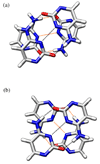Ultrafast excited-state dynamics of RNA and DNA C tracts
- PMID: 18574520
- PMCID: PMC2435405
- DOI: 10.1016/j.chemphys.2008.01.050
Ultrafast excited-state dynamics of RNA and DNA C tracts
Abstract
The excited-state dynamics of the RNA homopolymer of cytosine and of the 18-mer (dC)(18) were studied by steady-state and time-resolved absorption and emission spectroscopy. At pH 6.8, excitation of poly(rC) by a femtosecond UV pump pulse produces excited states that decay up to one order of magnitude more slowly than the excited states formed in the mononucleotide cytidine 5'-monophosphate under the same conditions. Even slower relaxation is observed for the hemiprotonated, self-associated form of poly(rC), which is stable at acidic pH. Transient absorption and time-resolved fluorescence signals for (dC)(18) at pH 6.8 are similar to ones observed for poly(rC) near pH 4, indicating that hemiprotonated structures are found in DNA C tracts at neutral pH. In both systems, there is evidence for two kinds of emitting states with lifetimes of ~100 ps and slightly more than 1 ns. The former states are responsible for the bulk of emission from the hemiprotonated structures. Evidence suggests that slow electronic relaxation in these self-complexes is the result of vertical base stacking. The similar signals from RNA and DNA C tracts suggest a common base-stacked structure, which may be identical with that of i-motif DNA.
Figures










References
-
- Callis PR. Ann. Rev. Phys. Chem. 1983;34:329.
-
- Crespo-Hernández CE, Cohen B, Hare PM, Kohler B. Chem. Rev. 2004;104:1977. - PubMed
-
- Pecourt J-ML, Peon J, Kohler B. J. Am. Chem. Soc. 2001;123:10370. - PubMed
-
- Peon J, Zewail AH. Chem. Phys. Lett. 2001;348:255.
-
- Onidas D, Markovitsi D, Marguet S, Sharonov A, Gustavsson T. J. Phys. Chem. B. 2002;106:11367.
Grants and funding
LinkOut - more resources
Full Text Sources
Miscellaneous
